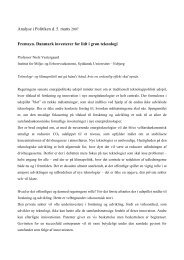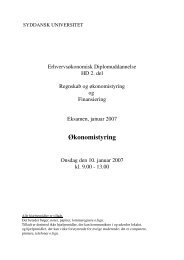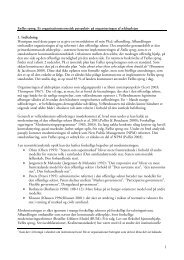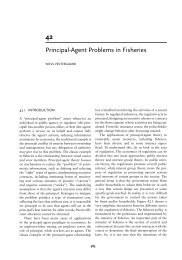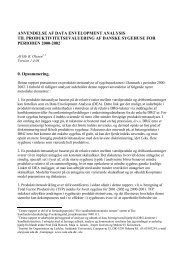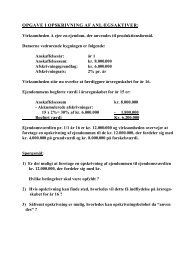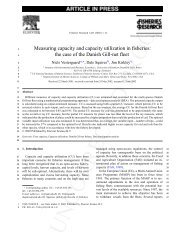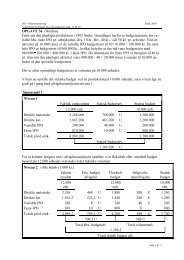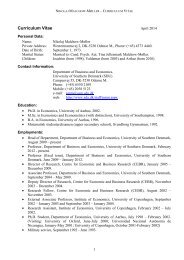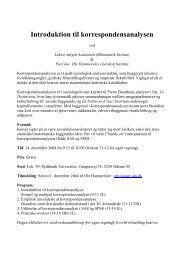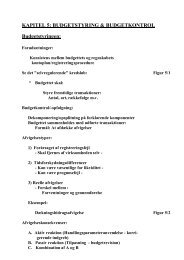Development of Parties and Party Systems in ... - lah@sam.sdu.dk
Development of Parties and Party Systems in ... - lah@sam.sdu.dk
Development of Parties and Party Systems in ... - lah@sam.sdu.dk
- No tags were found...
Create successful ePaper yourself
Turn your PDF publications into a flip-book with our unique Google optimized e-Paper software.
Cartel agreementsbetter representation <strong>in</strong> parliament bym<strong>in</strong>imiz<strong>in</strong>g the waste <strong>of</strong> votes atelectionsPower shar<strong>in</strong>g agreements, <strong>in</strong> whichcase the policy-content is neglected,the aim is to keep other parties out, themajority pr<strong>in</strong>ciple, “the w<strong>in</strong>ners take itall”Imposed agreements Cooperation between partiesestablished after heavy pressure fromthe <strong>in</strong>ternational society, i.e. the West,e.g. the EUFree “self chosen” alliancesSeveral coalition alternatives exist,only few historical structural obstacles<strong>and</strong> no pressure from the <strong>in</strong>ternationalsociety. Agreement on policy level isthe most important, old cleavageswhich may be barriers for coalitionbuild<strong>in</strong>g are de-freezed or nonexist<strong>in</strong>gHistorical compromise Cooperation overcom<strong>in</strong>g deephistorical, i.e. structural cleavages.Reflect de-freez<strong>in</strong>g <strong>of</strong> old e.g. “Weversus Them” cleavagesRepublic, “Przymierze Polski” <strong>in</strong>Pol<strong>and</strong> at the municipal <strong>and</strong> regionalelections <strong>in</strong> 1998.The agreements between ODS <strong>and</strong>CSSD <strong>in</strong> the Czech Republic after the1998 election, especially the first“opposition agreement” just after the1998 electionDifficult to f<strong>in</strong>d <strong>in</strong> the “pure” form,however the government establishedafter the 1998 <strong>and</strong> the 2002 election <strong>in</strong>Slovakia can be taken as examples.The governmental coalitionestablished after the 1998 <strong>in</strong> Hungarybetween FIDESZ <strong>and</strong> agrarian partyFKGP. FIDESZ could haveestablished a broad coalition with e.g.the Socialist <strong>Party</strong> (MSZP). After the2002 Czech election the CSSD couldhave cont<strong>in</strong>ued cooperation with ODS,but took the Coalition (K) as partner <strong>in</strong>governmentThe governmental coalition betweenthe Socialist <strong>Party</strong> (MSZP) <strong>and</strong> theliberal Alliance (SZDSZ) after the1994 election <strong>in</strong> HungaryThe rise <strong>of</strong> umbrella type parties has been caused by the fragmentation <strong>and</strong> party splits after the firstfree elections. The umbrella parties have an hegemonic core that dom<strong>in</strong>ates smaller parties. Smallparties, that might loose the parliamentary representation at a forthcom<strong>in</strong>g elections, may survive ifthey enter coalitions with stronger (”hegemonic”) parties <strong>in</strong> order to pass tresholds requirements<strong>and</strong> obta<strong>in</strong> seats <strong>in</strong> parliament. Most important is to m<strong>in</strong>imize waste <strong>of</strong> votes caused e.g. by highelection threshold requirements. Umbrella type <strong>in</strong>ter-party cooperation have been seen on both thepolitical right <strong>and</strong> left side <strong>of</strong> the political spectrum. Thus, the cooperation between MDF <strong>and</strong>FIDESZ <strong>in</strong> Hungary <strong>and</strong> between the Works Union (UP) <strong>and</strong> SLD <strong>in</strong> Pol<strong>and</strong> are examples <strong>of</strong> such“hegemonic” party-alliances. Before the 2002 election <strong>in</strong> Slovakia several new election alliancesemerged. Some were transformed to “parties” because <strong>of</strong> changes <strong>in</strong> the election rules, decided bythe Meciar led government.The umbrella parties <strong>and</strong> party alliances may change role <strong>and</strong> later constitute party federations witha stronger decision centre <strong>and</strong> even become unified st<strong>and</strong>ard parties. The question, however, is towhat extent the parties <strong>in</strong>volved are will<strong>in</strong>g to give up their own party identity. Unification <strong>and</strong>st<strong>and</strong>ardization has been especially difficult for parties with a long historic tradition <strong>and</strong> a wellestablished party culture.A third model was establishment <strong>of</strong> pure tactical alliancse (see figure ... ). In that case the parties<strong>in</strong>volved are capable to cooperate programmatically <strong>and</strong> put forward common lists at the elections,but they limit themselves to coord<strong>in</strong>ation on the policy-level without transform<strong>in</strong>g themselves <strong>in</strong>toparty federations that <strong>in</strong>clude “shadow cab<strong>in</strong>ets” <strong>and</strong> common long-term political programmes suchas <strong>in</strong> the case <strong>of</strong> AWS <strong>in</strong> Pol<strong>and</strong> <strong>and</strong> SDK <strong>in</strong> Slovakia. In other words, the parties ma<strong>in</strong>ta<strong>in</strong> theirown party identities <strong>and</strong> their own party <strong>in</strong>stitutions. For that reason the day to day policy problems28



